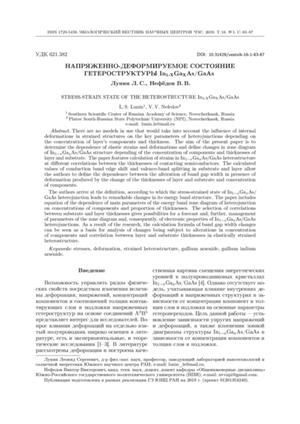Напряженно-деформируемое состояние гетероструктуры In1-xGaxAs/GaAs
УДК
621.382DOI:
https://doi.org/10.31429/vestnik-16-1-83-87Аннотация
Целью данной работы является установление зависимости упругих напряжений и деформаций, а также определение изменения зонной диаграммы структуры In1-xGaxAs/GaA в зависимости от концентрации компонентов и толщин слоя и подложки. В зависимости от отношения толщин контактирующих полупроводников рассчитаны напряжения в гетероструктуре In1-xGaxAs/GaA. Рассчитанные величины смещения краев зоны проводимости и расщепления валентной зоны подложки и слоя позволяют определить зависимость изменения ширины запрещенной зоны при наличии деформации от соотношения толщин слоя и подложки и концентрации компонент. Определено, что напряженно-деформированное состояние гетероперехода In1-xGaxAs/GaA заметно влияет на характеристики в энергетической зонной структуре. Построено уравнение зависимости основных параметров энергетической зонной диаграммы гетероперехода от концентраций компонентов и соотношения толщин. Подбор соотношений толщин подложки и слоя позволяет прогнозировать, а затем и управлять параметрами зонной диаграммы, следовательно, электронными свойствами гетеропереходов In1-xGaxAs/GaA. Выведенная в работе формула для расчета изменения ширины запрещенной зоны позволяет проанализировать это изменение в зависимости от концентрации компонентов и соотношения толщин слоя и подложки упругонапряженной гетероструктуры.
Ключевые слова:
напряжения, деформация, напряженная гетероструктура, арсенид галлия, арсенид индия галлияИнформация о финансировании
Публикация подготовлена в рамках реализации ГЗ ЮНЦ РАН на 2019 г. (проект 01201354240).
Библиографические ссылки
- Чеботарев С.Н., Лунина М.Л., Алфимова Д.Л., Еримеев Г.А., Гончарова Л.М., Мохамед А.А.А. Индуцированные механические напряжения и электрические поля в наногетероструктурах с квантовыми нитями // Наука Юга России. 2017. Т. 13. № 3. С. 18–26. [Chebotarev, S.N., Lunina, M.L., Alfimova, D.L., Erimeev, G.A., Goncharova, L.M., Mohamed, A.A.A. Inducirovannye mehanicheskie naprjazhenija i jelektricheskie polja v nanogeterostrukturah s kvantovymi nitjami [Induced mechanical stresses and electric fields in nanoheterostructures with quantum threads]. Nauka Juga Rossii [Science of the South of Russia], 2017, vol. 13, no. 3, pp. 18–26. (In Russian)]
- Курило И.В., Губа С.К. Дислокации несоответствия и напряжения в гетероструктурах In1-xGaxAs/GaAs // Неорганические материалы. 2011. Т. 47. № 8. С. 911–915. [Kurilo, I.V., Guba, S.K. Dislokacii nesootvetstvija i naprjazhenija v geterostrukturah In1-xGaxAs/GaAs [Dislocation mismatches and stresses in heterostructures In1-xGaxAs/GaAs]. Neorganicheskie materialy [Inorganic materials], 2011, vol. 47, iss. 8, pp. 911–915. (In Russian)]
- Kazuo Nakajima. Calculation of compositional dependence of stresses in GaInAs/GaAs strained multilayer heterostructures // J. of Crystal Grouth. 1993. Vol. 126. P. 511–524.
- Полякова А.Л. Деформация полупроводников и полупроводниковых приборов. М.: Энергия, 1979. 168 c. [Poljakova, A.L. Deformacija poluprovodnikov i poluprovodnikovyh priborov [Deformation of semiconductors and semiconductor devices]. Energija, Moscow, 1979. (In Russian)]
- Бир Г.А., Пикус Г.Е. Теории деформационного потенциала для полупроводников со сложной зонной структурой // ФТТ. 1960. Т. 2, № 9. С. 2237–2301. [Bir, G.A., Pikus, G.E. Teorii deformacionnogo potenciala dlja poluprovodnikov so slozhnoj zonnoj strukturoj [Theories of the deformation potential for semiconductors with a complex band structure]. FTT [Solid state physics], 1960, vol. 2, no. 9, pp. 2237–2301.(In Russian)]
- Ландау Л.Д., Лифшиц Е.М. Теоретическая физика. Т. VII. Теория упругости. М.: ФИЗМАТЛИТ, 2007. 264 с. [Landau, L.D., Lifshic, E.M. Teoreticheskaja fizika. Teorija uprugosti [Theoretical physics. Theory of elasticity]. Vol. VII, Fizmatlit, Moscow, 2007. (In Russian)]
- Филиппов В.В., Власов А.Н., Бормонтов Е.Н. Моделирование деформаций и зонной диаграммы гетероструктуры кремний-германий // Конденсированные среды и межфазные границы. 2010. Т. 12. № 3. С. 282–287. [Filippov, V.V., Vlasov, A.N., Bormontov, E.N. Modelirovanie deformacij i zonnoj diagrammy geterostruktury kremnij-germanij [Simulation of deformations and band diagrams of the silicon-germanium heterostructure]. Kondensirovannye sredy i mezhfaznye granicy [Condensed Matter and Interfaces], 2010, vol. 12, no. 3, pp. 282–287.]
- Безухов Н.И. Теория упругости и пластичности. М.: ГИТТЛ, 1953. 420 с. [Bezuhov, N.I. Teorija uprugosti i plastichnosti [Theory of elasticity and plasticity]. GITTL, Moscow, 1953.]
- Yu P.Y., Cardona M. Fundamentals of Semiconductors: physics and materials properties. Berlin: Springer, 2010. 775 p. [Yu, P.Y., Cardon, M. Fundamentals of Semiconductors: physics and materials properties. Berlin, Springer, 2010.]
- Manel Souaf, Mourad Baira, Olfa Nasr, Mohamed Helmi Hadj Alouane, Hassen Maaref, Larbi Sfaxi and Bouraoui Ilahi Investigation of the InAs/GaAs Quantum Dots' Size: Dependence on the Strain Reducing Layer's Position // Materials. 2015. Vol. 8. P. 4699–4709.
- Vurgaftman I., Meyer J.R., Ram-Mohan L.R. Band parameters for III–V compound semiconductors and their alloys // Journal of Applied Physics. 2001. Vol. 89, P. 5815.
- Новиков Б.В., Зегря Г.Г., Пелещак Р.М., Данькив О.О., Гайсин В.А., Талалаев В.Г., Штром И.В. Барические свойства квантовых точек InAS // Физика и техника полупроводников. 2008. Т. 42. Вып. 9. С. 1094–1101. [Novikov, B.V., Zegrja, G.G., Peleshhak, R.M., Dan'kiv, O.O., Gajsin, V.A., Talalaev, V.G., Shtrom, I.V. Baricheskie svojstva kvantovyh tochek InAS [Barometric properties of InAS quantum dots]. Fizika i tehnika poluprovodnikov [Semiconductor Physics and Technology], 2008, vol. 42, iss. 9, pp. 1094–1101. (In Russian)]
Скачивания

Загрузки
Даты
Поступила в редакцию
Принята к публикации
Публикация
Как цитировать
Лицензия
Copyright (c) 2019 Лунин Л.С., Нефёдов В.В.

Это произведение доступно по лицензии Creative Commons «Attribution» («Атрибуция») 4.0 Всемирная.


